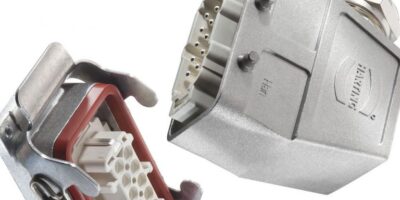Harting selects metal casting to combat environmental effects
To minimise adverse environmental effects in modern metal casting production facilities, Harting is using its Han High Temp connectors in metal die-casting production systems. The high-temperature connectors can reduce maintenance and service periods, line downtime and hence operating costs, explains the company.
Metal casting manufacturers are continually looking at ways to reduce environmental damaging emissions from their production process to satisfy stringent environmental regulations and minimise air pollution.
For example, in order to produce metal cast automotive engine component parts, sand is typically used with a mixture of organic binders as an important constituent part of the casting process. The organic binders can lead to the release of hazardous levels of air pollutants, reports Harting. There has been a call to apply types of inorganic binder materials mixed with sand in the process, which requires a slight modification to the die-cast tooling and the applied processes which requires the electrical heating processes applied to the tools to be adjusted, which in turn raises temperature levels to levels which have a detrimental impact on the life of the tools, based on the limited operating temperature range of the electrical interface connections.
Harting’s Han range of high-temperature connectors can help to reduce this negative impact condition and maximise the lifetime of the electrically heated metal sand casting tools. This reduces potential tooling maintenance and service periods, line downtime and hence operating costs.
The company cites the example of bulkhead-side connector seals which must not melt or stick to other integrated component parts over the full operating temperature range. Harting’s non-stick coated, high-temperature-resistant rubber version avoids bonding between the hood and housing even if they are left mated for a number of years.
Many of the hood and housing coatings and lacquers available on the market are not suitable for long-term use at high temperatures as they can cause melting, which can in turn lead to mated parts sticking together. A special surface treatment of the aluminium die-cast hoods and housings eliminates the need for any potentially detrimental additional protective coating finish, says Harting.
The insulating body and contacts must withstand both the high ambient conditions of the location and the additional heat generated inside the housing when under mated load. Other design elements are high-temperature-resistant copper alloy contacts which maintain constant electrical properties when heated and high-temperature LCP plastic insulators ensure long service life.
These characteristics combine in the High Temp connectors to enable them to permanently withstand operating ambient conditions of +200 degrees C, providing extended operating lifetimes and ensuring reduced line downtime compared to alternative solutions, concludes Harting.




